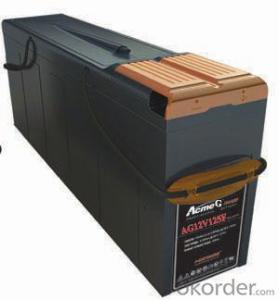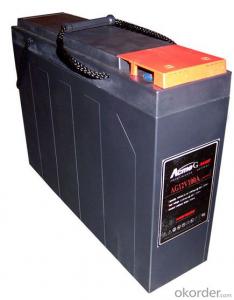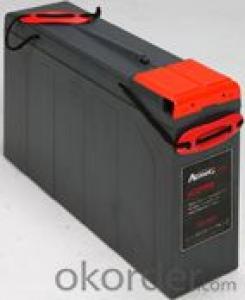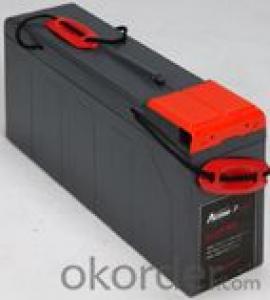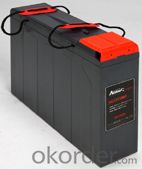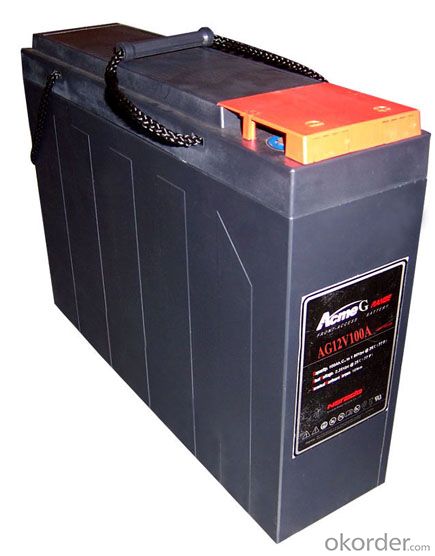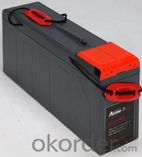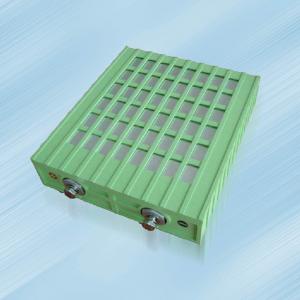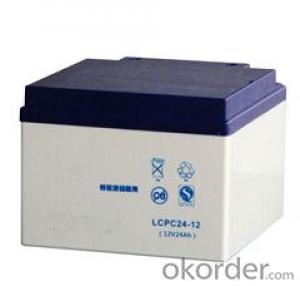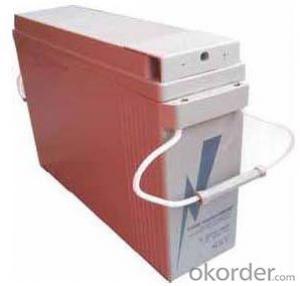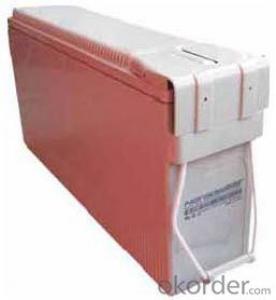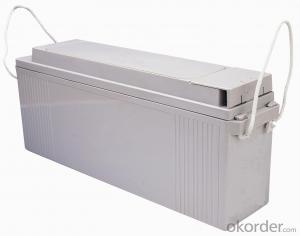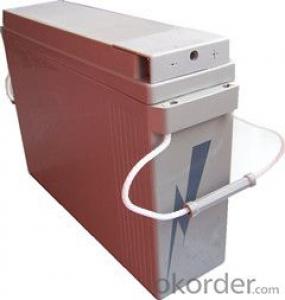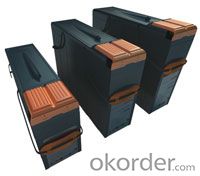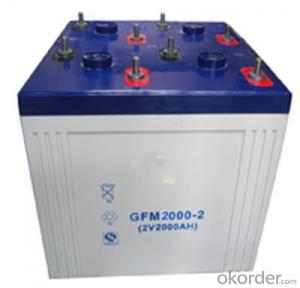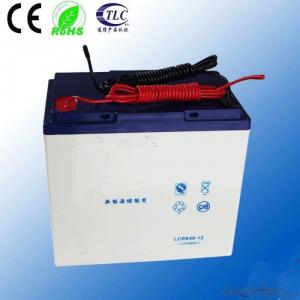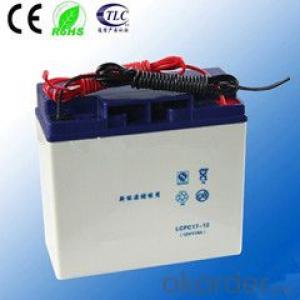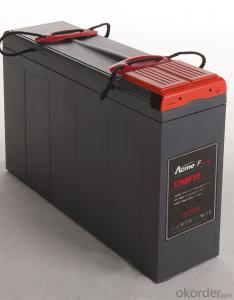Gel Battery the AcmeG Series Battery AG12V180
- Loading Port:
- Shanghai
- Payment Terms:
- TT OR LC
- Min Order Qty:
- 2000 unit
- Supply Capability:
- 600000 unit/month
OKorder Service Pledge
OKorder Financial Service
You Might Also Like
Range summary
The AcmeG range front access gel batteries is designed based on the Acme series, using the polymer gel electrolyte with real front access structure. The state-of the-art internal and external design ensures AcmeG the high reliability and makes the installation quite simple and safe when placed on a standard relay rack tray or in a closed cabinet. AcmeG range gel battery is designed with high energy density and suitable for 19". 23" rack or cabinet.
Technical features
Long life
Using the polymer gel electrolyte
4BS paste technology
Special paste formula
Special patented grid alloyWide operational temperature range
Excellent charging and discharging ability at low temperature
Decline the water-loss at high temperaturespecial structure
real front access structure makes the installation and maintenance squite simple and safe
suitable for 19". 23" rack or cabinet
The specially centralized venting system ensures the small gas be vented our of the closed cabinet
Type: | AG12V180 | |
Voltage: | 12V | |
Nominal Capacity: | 180Ah(C10) | 180Ah(10 hours rate:) |
Length: | 558mm | |
Width: | 125mm | |
Height: | 316mm | |
Height with termial: | 316mm | |
Weight: | 60.5Kg |
Compliant standards
Designed to be compliant with:
IEC 60896-2
BS 6290 Part 4
Telcordia SR-4228
EUROBAT GUIDE
UL
Manufactured under system ISO9001 & ISO14001 by NARADA
Battery installation compliant with:
EN 50272-2 or local equivalents
Main applications
Telecom standby and cyclical applications
UPS
Power plant and power transfer system
Solar energy system
Emergency lighting system
Products characteristics:
float voltage: 2.25Vpc at 77oF(25oC) , Equalization charge voltage: 2.40Vpc at 77oF(25oC)
Self discharge rate: < 2% pre month at 68oF(20oC)
Design life: more than 12 years at 68oF(20oC)
Shelf life: 6 months at 68oF(20oC)
Recombination efficiency: >99%
the Pressure at which the valve opens & reclose is Opened at 10 to 35kpa(1.45psi to 5.08psi) and
closed at 3 to 15 kpa (0.44psi to 2.18psi)
Temperature ranges: -40oC to 50oC
Terminal Hardware Torque:10±0.1N m
Container Material: ABS (V0 optional)
FAQ
![]() What is a Gel Cell Battery?
What is a Gel Cell Battery?
A gel battery design is typically a modification of the standard lead acid automotive or marine battery. A gelling agent is added to the electrolyte to reduce movement inside the battery case. Many gel batteries also use one way valves in place of open vents, this helps the normal internal gasses to recombine back into water in the battery, reducing gassing. "Gel Cell" batteries are non-spillable even if they are broken. Gel cells must be charged at a lower voltage (C/20) than flooded or AGM to prevent excess gas from damaging the cells. Fast charging them on a conventional automotive charger may be permanently damage a Gel Battery.
![]() What is sulfation of batteries?
What is sulfation of batteries?
Sulfation is the formation or deposit of lead sulfate on the surface and in the pores of the active material of the batteries' lead plates. If the sulfation becomes excessive and forms large crystals on the plates, the battery will not operate efficiently and may not work at all. Common causes of battery sulfation are standing a long time in a discharged condition, operating at excessive temperatures, and prolonged under or over charging.
![]() How long a battery can last?
How long a battery can last?
The service design life of a battery are vary considerably with how it is used, how it is maintained and charged, temperature, and other factors.
![]() Do batteries self-discharge when not in use?
Do batteries self-discharge when not in use?
All batteries, regardless of their chemistry, self-discharge. The rate of self-discharge depends both on the type of battery and the storage temperature the batteries are exposed to. However, for a good estimate, Narada batteries self-discharge approximately 4% per week at 80ĄăF.
- Q: How is the capacity of the battery defined?
- 100AH capacity of the battery, fully charged after the 100A current discharge can be an hour to put the power finished. 50A current is 2 hours put away! 20A is 5 hours! Of course this is the theoretical value, in fact it is impossible to have a constant current discharge.
- Q: How to determine the battery is good or bad?
- If less than 9V but the pointer is in a certain value does not move that the battery is in a state of loss, need to add charge.
- Q: How to deal with waste batteries?
- Laboratory recycling method: ordinary dry battery is cylindrical, the outer cylinder made of zinc, the zinc cylinder is the battery negative; tube central carbon rod for the positive; tube for the manganese dioxide, ammonium chloride and chlorination Zinc.
- Q: What are the hazards of battery over discharge?
- When the battery discharge current is large, the heat will become more obvious, there will be serious heat generated when the battery deformation, when the concentration of lead sulfate is particularly large, will form a larger crystal particles, that lead to the battery Internal irreversible sulfation.
- Q: Maintenance-free battery how to detect it?
- Do not always check the color of the electric eye for maintenance-free batteries. Green for the full power; black for the lack of electricity, need to be added to charge; gray or light yellow for the electrolyte is insufficient, because maintenance-free battery can not add liquid, should immediately replace the battery.
- Q: What battery does the van use?
- The most obvious feature of lead-acid batteries is the top of the plastic cover can be unscrewed, there are ventilation holes above. These fillers are used to fill pure water, check the electrolyte and the use of exhaust gas. In theory, lead-acid batteries need to check the density of each electrolyte and the level of liquid, if there is a need to add distilled water. But with the upgrading of battery manufacturing technology, lead-acid battery development for the lead-acid maintenance-free batteries and colloidal maintenance-free batteries, lead-acid batteries do not need to add electrolyte or distilled water. Mainly the use of positive electrode to produce oxygen can be absorbed in the negative oxygen cycle, to prevent water reduction. Lead-acid water batteries are mostly used in tractors, tricycles, car start, etc., and maintenance-free lead-acid battery wider range of applications, including uninterruptible power supply, electric vehicle power, electric bicycle batteries. Lead-acid batteries according to the application needs to be divided into constant current discharge (such as uninterruptible power supply) and instantaneous discharge (such as car to start the battery).
- Q: 80ah how much battery storage capacity?
- The size of the battery storage power refers to the battery capacity. Battery capacity is generally calculated in AH (safety). You 80Ah battery capacity is 80Ah, meaning that if you discharge current to 80A, you can put an hour.
- Q: How does the battery increase the voltage?
- Chemical energy can be converted into electrical energy device called chemical battery, generally referred to as the battery. After discharge, the internal active material can be regenerated by charging - the electrical energy stored as chemical energy; chemical energy can be converted to electrical energy again when the discharge is required. This type of battery is called a battery (Storage Battery), also known as secondary battery.
- Q: Battery 200ah / 104 what does that mean?
- This should be refers to 2V200AH battery 104, power with the 220V. Lead-acid battery nominal voltage is 2V / (each or monomer), but in fact will be higher than 2V, so the actual use and charging equipment for the matching will use 104, also useful 103, also useful 108 Only.
- Q: Lead-acid battery how to maintain?
- When receiving the battery should first check whether the phenomenon of short circuit, first short circuit repair and then fill the distilled water.
Send your message to us
Gel Battery the AcmeG Series Battery AG12V180
- Loading Port:
- Shanghai
- Payment Terms:
- TT OR LC
- Min Order Qty:
- 2000 unit
- Supply Capability:
- 600000 unit/month
OKorder Service Pledge
OKorder Financial Service
Similar products
Hot products
Hot Searches
Related keywords
